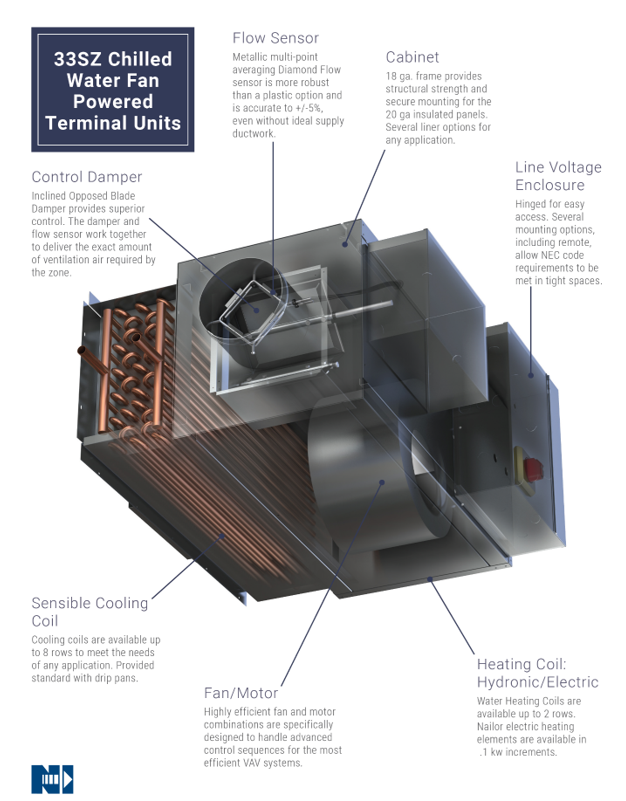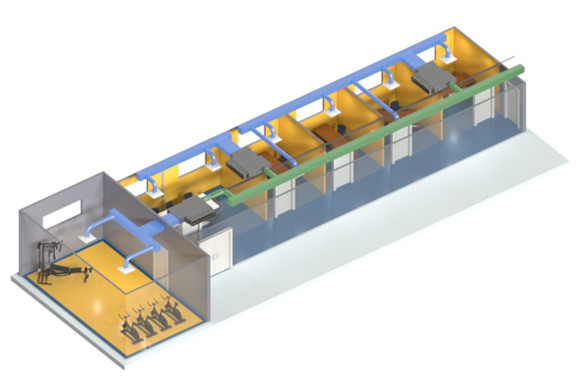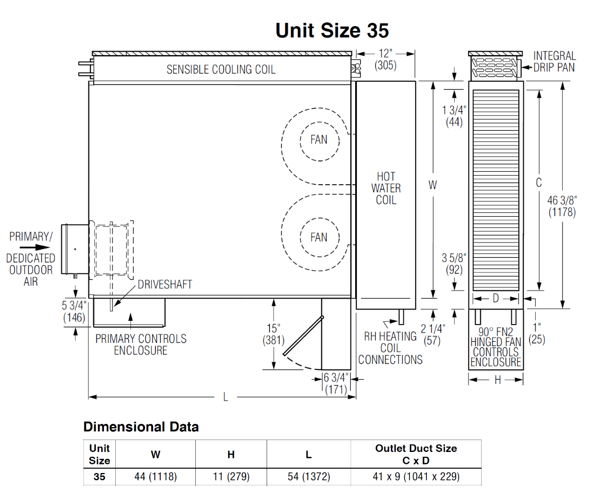
The most advanced system for delivering, controlling, and optimizing ventilation air utilizes Chilled Water Fan Powered Terminal Units. With this system, the DOAS unit handles the conditioning of the ventilation air and the latent load within the building. The system eliminates the need for the recirculating air system to handle latent loads and distributes the sensible cooling into the space.
Achieving this system requires series fan-powered terminal units that are equipped with a sensible cooling coil, eliminating the need for the building air handling unit.
Chilled Water Fan Powered Terminal Units
Chilled water fan-powered terminal units contain the following parts:
- Flow Sensor
- Damper
- Fan
- Sensible Cooling Coil
- Optional – Heating Coil
The dedicated outside air unit supply is ducted to the inlet of the CWFPTU. The flow sensor on the inlet measures the amount of air coming into the unit from the DOAS system. The damper responds to the call in the space for ventilation air. In spaces that are unoccupied part of the time, such as a conference room, an occupancy sensor can tell the damper to shut off ventilation air during the unoccupied period. The VAV DOAS system will respond accordingly to manage the proper amount of ventilation air to the building.

The fan in the terminal unit is responsible for delivering the ventilation air to the space. Because the fan is in series with the airflow, the DOAS system fan is only required to deliver the ventilation air to the terminal unit. When the call for cooling in the space is greater than what is provided by the DOAS unit, the fan will increase its speed to deliver additional air. The fan induces air through the sensible coil from the plenum. In this mode, the recirculated air is mixed with the ventilation air within the terminal unit and distributed to the space as one airflow.
The combined airflows eliminate the stratification caused by ducting the two airflows separately to the space.
The coil is cooled using ~57º F water, which is higher than the dew point in the space, eliminating a condensate drain from the unit. When equipped with modulating valves, the fan can respond with the coil with the exact amount of cooling needed to satisfy the demand in the space.
This system allows each occupancy in the building to control ventilation and comfort. Shown below, the offices will have a ventilation supply that is measured and controlled by their terminal unit, while the gym is controlled separately. With a variable volume DOAS unit, the occupancy sensor in the room can determine when it is unoccupied and reduce the ventilation to 0, saving energy for the building operations.

The latent load is handled by the dry air from the DOAS air handling unit. Also, the building exhaust ensures the room air is replaced throughout the day.
Nailor Solutions
Nailor has been the leader in Series Fan Powered Terminal Unit technology for over 25 years, including being the first provider of the Chilled Water version. Over time we have optimized and expanded on the 33SZ units to provide the quietest and most efficient units with the flexibility of several options. The portfolio includes a size 10 that can control as low as 100 CFM and a size 55 that will go as high as 2,000 CFM. The units can have an up to 8-row coil for a max of 3 tons of cooling. Low-profile models are available when ceiling space is a concern; the height of these units is only 11". Standard units have a height of 18". The full information on the portfolio is found here.




